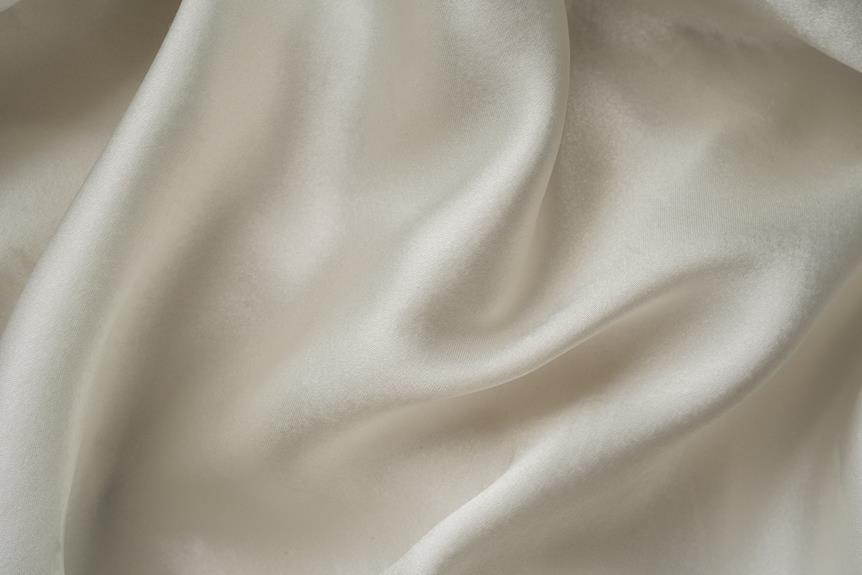Curious about satin's breathability? You've come to the right place. In 'Is Satin Breathable? The Ultimate Fabric Guide,' you'll delve into the intricacies of this luxurious fabric.
Unravel the mystery behind satin's breathability, understand the factors that influence it, and gain expert tips for selecting and caring for breathable satin garments.
Whether you're aiming for comfort or style, mastering the art of styling with breathable satin is within reach. This guide is your key to unlocking the potential of satin, empowering you to make informed choices and elevate your wardrobe with confidence.
Key Takeaways
- Satin fabric is made from silk, polyester, or nylon.
- Satin has a smooth and lustrous surface, with a glossy front and a dull back.
- Satin fabric is breathable and allows air circulation due to its smooth weave.
- Satin made from natural fibers like silk or cotton is more breathable than synthetic satin.
What Is Satin Fabric
Satin fabric is a glossy material made from silk, polyester, or nylon. Its hallmark characteristics are its smooth and lustrous surface, which is a result of a unique weaving technique. Unlike other fabrics, satin has a glossy front and a dull back due to the specific weaving method used in its production. This luxurious material drapes beautifully and is often used in evening gowns, lingerie, and bedding.
Satin is produced using a weaving technique that involves a complex combination of fibers. This process results in a fabric with a high thread count, which contributes to its characteristic smoothness and sheen. The weaving technique also gives satin its signature drape and luster, making it a popular choice for elegant and formal wear.
Understanding the characteristics and production of satin fabric allows you to appreciate its unique appeal and versatility. Whether you're considering satin for clothing or home decor, knowing how it's made and what sets it apart can help you make informed decisions when choosing the perfect fabric for your project.
The Breathability of Satin
When it comes to breathability, satin fabric is known for its ability to keep you cool and comfortable due to its smooth weave and lightweight nature. Satin's properties make it an excellent choice for summer wear, allowing your skin to breathe and reducing the risk of overheating. The weave of satin fabric is tight, but it still allows for air circulation, making it ideal for warm weather.
Satin's smooth surface also means less friction against your skin, reducing the likelihood of sweat and moisture becoming trapped. This feature not only enhances comfort but also contributes to the fabric's breathability. Additionally, satin's lightweight nature adds to its breathability, as it doesn't weigh you down or restrict airflow.
When considering summer wear, satin stands out as a versatile option that offers both style and comfort. Its breathability makes it suitable for various clothing items, from dresses to shirts, allowing you to stay cool and elegant in hot weather.
With its breathable properties and luxurious feel, satin is a go-to choice for staying comfortable and chic during the summer months.
Factors Affecting Satin's Breathability
When it comes to satin's breathability, several factors come into play. The material composition, the weave and density, and any finishing treatments can all affect how well satin allows air to pass through.
Understanding these factors can help you make informed choices about the satin fabrics you use in your clothing and home decor.
Material Composition's Impact
Consider the material composition of satin as it directly influences its breathability, impacting how comfortable it feels against your skin.
Satin is commonly made from materials like silk, polyester, acetate, or nylon. Each material has unique properties that affect breathability.
Silk, a natural fiber, is breathable and has excellent moisture management, making it ideal for temperature regulation.
On the other hand, polyester and nylon, being synthetic fibers, are less breathable and may not manage moisture as effectively.
The material properties of satin determine its ability to allow air to pass through and wick away moisture, affecting how cool and dry it keeps you.
When selecting satin products, understanding the material composition is crucial in ensuring optimal breathability for your comfort.
Weave and Density
To assess the breathability of satin, examine the weave and density of the fabric. The weave types and thread count play a crucial role in determining how breathable satin is. Here's what to consider:
- Weave Types: Look for satin weaves like sateen or charmeuse, known for their smooth, lustrous finish.
- Thread Count: A higher thread count generally indicates a tighter weave, potentially impacting air permeability.
- Air Permeability: Tight weaves may reduce breathability, while looser weaves allow for better air circulation.
- Moisture Wicking: Consider how well the fabric wicks away moisture. Satin with good moisture-wicking properties can enhance breathability.
Understanding these factors can help you select a satin fabric that balances the luxurious feel of satin with adequate breathability.
Finishing Treatments' Influence
One factor that significantly influences the breathability of satin fabric is the type of finishing treatments applied to the fabric. Finishing techniques play a crucial role in determining how breathable satin will be.
Innovations in textile finishing have led to a variety of treatments that can affect the breathability of satin. For instance, certain finishing treatments, such as silicone softeners, can reduce the breathability of satin by filling in the gaps between the fibers, creating a smoother surface.
On the other hand, innovative finishing techniques focused on enhancing breathability can help maintain the fabric's airflow properties. Understanding the impact of finishing treatments on satin's breathability empowers you to make informed decisions when selecting satin fabric for different purposes.
Keep in mind the influence of finishing treatments when considering the breathability of satin.
Tips for Choosing Breathable Satin Clothing
When choosing breathable satin clothing, there are a few key points to keep in mind.
Consider the satin's breathability factors, such as weave and fiber content, to ensure optimal comfort.
Look for satin fabrics like silk or polyester satin, which are known for their breathability and ability to keep you cool.
Satin Breathability Factors
You should consider the breathability of satin when choosing clothing, as it can greatly impact your comfort. Satin's breathability and moisture control are influenced by several factors:
- Fiber Type: Satin made from natural fibers like silk or cotton tends to be more breathable than synthetic satin.
- Thread Count: A lower thread count allows for better air circulation, enhancing breathability.
- Weave: A loose satin weave allows for more airflow, making the fabric more breathable.
- Lining: Opt for satin clothing with breathable linings to improve overall breathability and comfort.
Understanding these factors will help you select satin clothing that not only looks luxurious but also feels comfortable and breathable against your skin.
Best Satin for Breathability
To ensure optimal breathability when selecting satin clothing, prioritize natural fibers such as silk or cotton for enhanced comfort. Satin made from these materials tends to be more breathable compared to synthetic satin types.
When choosing satin for breathability, it's essential to consider the thread count. A higher thread count often indicates a tighter weave, which can reduce breathability.
Additionally, consider conducting breathability tests before making a purchase. Hold the fabric up to the light to see how much light passes through. If the fabric is dense and allows little light through, it may not be as breathable.
Keep in mind that satin, by nature, isn't as breathable as some other fabrics, but opting for natural fibers and conducting simple tests can help you find the most breathable satin for your clothing needs.
Caring for Breathable Satin Garments
Caring for breathable satin garments involves gently hand washing them in cold water to maintain their delicate texture and ensure longevity.
Here are four essential steps to care for your breathable satin garments:
- Use a mild detergent: Opt for a gentle, pH-neutral detergent to preserve the fabric's breathability and prevent any damage to the delicate fibers.
- Avoid wringing or twisting: After washing, gently press the water out of the garment without twisting or wringing it, as this can distort the fabric and affect its breathability.
- Air dry: Lay the garment flat on a clean towel to air dry. Avoid hanging it, as this can stretch the fabric and potentially compromise its breathability.
- Store properly: When not in use, store your breathable satin garments in a cool, dry place away from direct sunlight. Hanging them in a breathable garment bag can help protect them from dust and excessive exposure to air.
Styling With Breathable Satin
When styling with breathable satin, consider incorporating it into your wardrobe for a touch of elegance and comfort. Satin is a versatile fabric that can elevate any outfit, whether it's a formal event or a casual day out. Here are some ideas for incorporating breathable satin into your style:
| Occasion | Styling Tip | Example |
|---|---|---|
| Formal Events | Opt for satin accessories like a clutch or heels to add a luxurious touch to your ensemble. | Satin clutch with a sleek evening gown. |
| Casual Outings | Pair a breathable satin scarf with a simple t-shirt and jeans for a chic and effortless look. | Satin scarf with a white t-shirt and denim. |
| Loungewear | Invest in breathable satin bedding for a comfortable and luxurious night's sleep. | Satin pillowcases and sheets for a touch of indulgence. |
Incorporating breathable satin into your style allows you to enjoy its luxurious feel while staying comfortable. Whether through accessories or bedding, satin adds a touch of sophistication to any occasion.
Frequently Asked Questions
Can Satin Fabric Be Used for Outdoor Activities or in Hot Climates?
Satin fabric is not ideal for outdoor activities or hot climates due to its lack of breathability. It doesn't effectively wick away moisture or optimize airflow, leading to discomfort in warm conditions.
Are There Specific Types of Satin That Are More Breathable Than Others?
When it comes to satin types, breathability can vary. Some satin weaves, like charmeuse, tend to be more breathable due to their lightweight and smooth texture. It's important to consider the specific type of satin for optimal comfort in different climates.
How Does the Weave of Satin Fabric Affect Its Breathability?
The weave of satin fabric directly impacts its breathability. A satin weave creates a smooth, shiny surface that can trap heat and moisture. However, some satin fabrics are designed with moisture-wicking and cooling properties to enhance breathability.
Can Satin Fabric Be Blended With Other Materials to Improve Breathability?
You can blend satin with natural fibers like cotton or silk for improved breathability. These blends allow for better airflow and moisture-wicking properties. Breathability testing can help determine the effectiveness of different blending options.
Are There Any Special Care Instructions for Maintaining the Breathability of Satin Garments?
To maintain the breathability of your satin garments, special care is essential. Avoid harsh detergents and opt for gentle washing methods to preserve the fabric's airflow properties, especially if you'll be wearing them for outdoor activities in hot climates.
- Does Chiffon Fabric Stink - July 15, 2025
- Does Chiffon Fabric Affect the Economy - July 15, 2025
- Does Cotton Fabric Have a Nap - July 15, 2025






